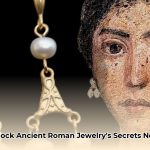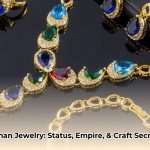Ever wondered what kind of adornments the Romans wore in their daily lives? Forget simple gold chains; we are delving into a world where necklaces were powerful statements of social status, personal beliefs, and artistic mastery. Far from being mere trinkets, these ancient Roman necklaces were intricate works of art, each laden with profound meaning. Learn more about them through this resource on roman jewelry. Join us as we explore the captivating history of these remarkable pieces, tracing their inspirations from other ancient civilizations, dissecting their elaborate craftsmanship, decoding their hidden symbols, and understanding their continued influence on modern jewelry design.
The Language of Adornment: Roman Jewelry and Its Origins
Roman jewelry was never solely about aesthetics; it articulated a complex language of status, belief, and artistic prowess. During the early Republic, the sophisticated metalworking techniques of the Etruscans seamlessly merged with the compelling narratives found in Greek mythology. This intricate blend, further infused with the Egyptian reverence for shimmering gold and precious gemstones, culminated in a style uniquely Roman. It was akin to a master chef expertly combining distinct flavors to create an entirely new, unforgettable culinary experience.
Materials as Social Narratives
The materials chosen for an ancient Roman necklace inherently communicated a story, often before a single word was spoken. Consider the hierarchy reflected in their choices:
- Gold: Serving as the undisputed symbol of prestige and immense power, gold was the preferred material for the upper echelons of society, particularly the patricians (upper-class citizens). They conspicuously displayed their wealth through opulent adornment. While initially rare, gold’s use in jewelry became fashionable as the empire expanded and resources flowed in, eventually becoming a primary material for artisans.
- Silver and Bronze: These options offered a more accessible elegance, allowing a broader segment of the Roman populace to participate in the widespread trend of personal ornamentation without requiring vast fortunes. Bronze, bone, and jet were common for bracelets among all ages.
- Gemstones: Precious stones like emeralds, sapphires, rubies, and amethysts were not merely chosen for their beauty. Each gem carried profound symbolic weight, linked to specific deities, virtues, or protective qualities. For instance, an amethyst might subtly suggest sobriety or protection against intoxication, while an emerald often represented Venus, the goddess of love. Garnets, peridots, jasper, and lapis lazuli were commonly imported from Egypt, while onyx, amber, and moonstone arrived from the Persian Gulf.
- Pearls: Initially a luxury reserved exclusively for the most affluent until the end of the Republic, pearls were often fashioned into elaborate earrings known as crotalaria (rattles) from clusters of large pearl beads. Emperor Caligula was famously extravagant with pearls, rumored to have even adorned his horse with a pearl necklace.
- Amber: Known as “The Gold of the North,” amber was highly favored by Roman jewelers. A famous expedition during Emperor Nero’s reign reportedly brought back enough amber to construct an entire gladiatorial stadium. Romans also believed amber possessed curative properties, further boosting its popularity.
- Glass Beads: A remarkably ingenious and cost-effective innovation, glass beads could skillfully emulate the appearance of much rarer and more expensive stones. Skilled glassblowers created pieces so convincing they mimicked real gemstones, dramatically diversifying possibilities for personal embellishment across social strata.
Beyond Embellishment: The Deeper Meanings
Roman necklaces were far more than simple decorations; they acted as potent communicators within society, often serving as a powerful marker of identity, wealth, and rank.
- Wealthy Romans: For the elite, necklaces—alongside bracelets, opulent earrings, and elaborate fibulae (brooches or pins used to fasten garments)—functioned as visible declarations, overtly showcasing their elevated position within the social hierarchy. The more elaborate the piece, the greater the statement of affluence. Necklaces featured delicate woven chains, intricate pendant designs, and meticulously carved gemstone settings.
- Everyday Romans: Simpler charms, amulets (objects worn for protection), and basic rings provided avenues for individual expression. These items also offered perceived protection, believed to ward off misfortune or malevolent spirits. For example, bracelets coiled into the form of serpents represented the promise of immortality and rebirth, an idea as compelling today as it was two millennia ago.
Masters of Metal and Gem: Roman Craftsmanship
The jewelers of ancient Rome were unequivocally skilled artisans, transforming raw materials into wearable art. They demonstrated remarkable proficiency in a variety of advanced techniques:
- Granulation: A sophisticated method where minuscule metal balls were meticulously fused onto a larger metal surface using heat, creating richly textured and intricate patterns. This technique was largely adopted from Etruscan artisans.
- Filigree: Delicate ornamental work created by twisting fine wires into elaborate patterns, often used to create a lacelike effect.
- Cameo Carving: The art of creating miniature, raised scenes or detailed portraits in relief on various materials, typically multi-layered gemstones or shells.
- Intaglio Carving: The opposite of cameo, intaglios involved meticulously carving designs into the surface of a gemstone. These were often used as seals to authenticate documents and secure written communications. Engraving on gold existed since the Late Minoan period but became highly valued in Rome, with artisans using abrasive powders over months to carve intricate designs.
- Opus Interrasile: This technique, meaning “work pierced through,” involved cutting out intricate designs from sheet gold using chisels. While early Etruscan works showed hints of this, it became widespread in the second century A.D., allowing for delicate and detailed patterns.
- Casting: Romans were skilled in casting gold and silver, allowing for intricate patterns and designs to be replicated efficiently, making jewelry more accessible to a broader audience through mass production techniques.
- Gemstone Cutting: Expertly transforming crude stones into dazzling, faceted jewels, or smooth cabochons.
These advanced methods enabled them to produce an astonishing array of items, from lavishly elaborate multi-strand necklaces to delicately ornamented earrings and brooches.
Decoding the Symbols: Roman Necklace Iconography
Every dolphin, bird, flower, coil, and snake meticulously incorporated into a Roman necklace carried significant meaning. Snakes frequently symbolized immortality and renewal, while dolphins were often associated with safe passage, particularly by sea, and love, happiness, and good luck. Birds, conversely, were commonly interpreted as a sign of freedom and hope. Fish-shaped necklaces were believed to symbolize fertility and protect the wearer from evil.
Beyond animal motifs, depictions of human figures and deities also held profound cultural significance. Venus, for instance, embodied beauty and love, whereas Jupiter represented supreme power and overarching authority within the Roman pantheon. Cross necklaces, symbolic of Christian beliefs, gained popularity during the Roman Empire, crafted from gold, silver, or bone and often adorned with precious stones. Necklaces with the emperor’s image stamped upon them or featuring a gemstone set in precious metals were also highly favored.
Rome’s Enduring Legacy in Modern Jewelry
Despite the Roman Empire’s eventual decline, its distinctive jewelry styles continue to resonate deeply within contemporary design. Modern jewelers and designers consistently draw inspiration from those ancient aesthetics: the bold and confident use of gold, the intricate and precise detailing, and the captivating allure of prominent gemstones. It is, in essence, a design DNA that perpetually re-emerges across generations. Contemporary Italian jewelry houses, in particular, often consciously incorporate ancient Etruscan craftsmanship techniques like granulation or filigree, bringing historical artistry into the modern age. This revival of Roman jewelry does more than just pay tribute to its historical significance; it also allows individuals to feel connected to an ancient civilization renowned for its grandeur and splendor.
Experiencing History: Roman Jewelry in Exhibitions
Do you wish to observe these historical artifacts firsthand? Visiting a museum offers an unparalleled experience. Museum collections function as veritable time machines, offering invaluable insights into the daily lives of ancient Romans and the profound societal significance of jewelry within their world. Major archaeological sites like Pompeii and Herculaneum have unearthed stunning pieces, providing crucial insights into first-century jewelry preferences. It is truly remarkable to consider our ability to connect with an empire long past through the tangible beauty of these preserved artifacts.
Ancient Roman Necklace: Pricing and Acquisition Guide
Dreaming of acquiring a tangible piece inspired by ancient Rome? Here’s a breakdown of what to expect:
| Type of Necklace | Price Range | Where to Buy | Authenticity Checks |
|---|---|---|---|
| Authentic Pieces | \$100s – \$10,000s+ | Reputable auction houses (e.g., Sotheby’s, Christie’s), specialized high-end antique dealers, and established private collectors. Items often command premium prices due to their rarity, historical significance, and the extensive archaeological and preservation efforts required for their recovery and display. | Thorough documentation, formal certifications of provenance, and independent expert opinions are crucial. Extensive research and consultation with an art historian or archeologist specializing in Roman artifacts are essential. |
| Museum Replicas | \$20 – \$200 | Museum gift shops, both brick-and-mortar and online, often found at major institutions with Roman collections. | Generally reliable, as these replicas are produced with an emphasis on historical accuracy and educational value, often directly overseen by museum curators. |
| Inspired Designs | \$10 – \$1,000s | Diverse online marketplaces such as Etsy and Amazon, as well as mainstream jewelry stores, independent artisans, and boutiques specializing in historical designs. This category generally features a wider range of accessible price points, from fashion jewelry to high-end creations crafted with precious metals and stones. | Scrutinize materials and craftsmanship quality, read customer reviews, and verify the seller’s reputation. Look for clear descriptions of materials used (e.g., sterling silver, gold-plated, gemstones, glass). |
Navigating Authenticity: A Buyer’s Precaution
Before committing any substantial funds to a piece marketed as genuinely “ancient,” it is imperative to conduct thorough due diligence. Always seek robust documentation, verifiable certifications of provenance (the history of ownership), and, whenever possible, obtain a professional expert opinion from a recognized art historian or archaeologist specializing in Roman artifacts. This diligent approach ensures you are acquiring a genuine artifact and not inadvertently investing in a cleverly crafted reproduction. Remember that many surviving authentic Roman jewelry pieces, especially those cast in iron, have degraded over time, making finely preserved pieces incredibly rare and valuable.
The Culture of Adornment: Insights into Roman Jewelry Usage
Roman jewelry was never merely decorative; it functioned as a powerful signifier. It eloquently communicated an individual’s social standing, accumulated wealth, and even personal triumphs. Unlike the Greeks, who primarily focused on the craftsmanship of fine metals, Romans harbored a profound affinity for vibrant colored stones and glass. This discernible love of ostentation developed as their expansive empire granted them access to a dazzling spectrum of materials, ranging from deep red garnets to translucent Baltic amber.
Status, Wealth, and Personal Achievement
Roman jewelry explicitly communicated your social standing, wealth, and triumphs. Archaeological findings consistently indicate a direct correlation between the intricacy and material value of Roman jewelry and the social status of its presumed owner. Senators and bureaucrats, for instance, flaunted massive, eye-catching gold rings often set with generously sized gemstones, instantly signaling their elevated position. Plebeians (common citizens) typically wore simpler iron rings unless granted the exceptional privilege of wearing gold as a reward for distinguished service in battle. Rings varied greatly in design, from simple motifs to elaborate patterns, using materials like silver, gold, bronze, iron, and jet.
Gender and Jewelry: Distinctive Roles
Jewelry played a significant, if distinct, role in Roman gender dynamics. Roman women traditionally amassed more pieces than men, lavishing themselves with an array of necklaces, bracelets, rings, earrings (specifically, boat-shaped earrings became very popular), and fibulae. Intriguingly, a woman’s jewelry was considered her exclusive personal property, entirely free from her husband’s legal control. This autonomy allowed women a form of independence and financial security, as they could buy, sell, or bequeath their jewelry as they saw fit. Roman men generally favored multiple rings and fibulae, with gold rings specifically reserved for senators, unequivocally marking their elevated rank, a distinct contrast to Greek men who traditionally wore a single ring.
Protecting the Young: Children’s Amulets
Even Roman children were not exempt from the allure and practical use of jewelry. They commonly wore protective amulets around their necks, such as the bulla (a protective amulet pouch, often lenticular, worn around the neck), to ward off illness and misfortune. The material of a bulla depended on social class, ranging from leather for commoners to bronze or gold for the elite. Young boys, in particular, often sported a fascinus (a phallic symbol believed to ward off evil influences) to further deflect negative energies, with materials varying from bronze and gold to ivory and green glass.
Sacred Offerings: Jewelry in Roman Temples
The utility of jewelry extended far beyond mere self-adornment. Archaeological hoards discovered at various Roman temples indicate that jewelry was frequently offered as votive gifts to deities, underscoring its profound significance in religious practices. Following the successful conquest of Greek cities, gold wreaths and elaborate diadems became notably popular as funerary items, showcasing a fascinating blend of cultural influences. Mummy portraits also reveal that Roman women used hairpins, sometimes crafted from gold, to manage and adorn their hairstyles.
Regulating Luxury: Sumptuary Laws
Did every Roman citizen freely flaunt their finest adornments without restraint? Not entirely. Sumptuary laws (laws regulating luxury and expenditure), such as those enacted by Cato the Elder, periodically attempted to curb excessive public displays of luxury, particularly among women. These legislative efforts aimed to temper overt exhibitions of wealth, reflecting a persistent tension between societal norms and individual desires for ostentation.
How Did Romans Maintain Their Jewelry?
While specific cleaning methodologies are not extensively detailed in surviving Roman texts, we can reasonably infer how Romans likely maintained their jewelry based on available resources and material properties. Their cleaning methods would have been inherently gentle, reliant on readily available natural materials due to the absence of modern harsh chemical agents.
- Water and Gentle Abrasives: It is highly probable that Romans utilized water, perhaps combined with fine sand, pulverized pumice stone, or ash, to gently scrub away accumulated dirt and grime from their metal pieces.
- Olive Oil: A ubiquitous household staple in ancient Rome, olive oil could have been effectively employed to polish and protect metal jewelry, particularly items incorporating gemstones. Its natural properties would enhance luster and potentially create a protective barrier against tarnishing or corrosion.
- Herbal Infusions and Natural Acids: Certain herbs (like soapwort) and natural acids (such as diluted vinegar or citrus juice) were historically recognized for their inherent cleaning properties. Therefore, infusions prepared from these botanicals or mild acidic solutions might have been used as gentle, non-corrosive cleaning agents for delicate pieces or to remove stubborn tarnish.
- Fabric Polishing: Soft cloths made from linen or wool would have been used for buffing and polishing the surfaces of metals and smooth gemstones, maintaining their shine.
Understanding the function and maintenance of jewelry within Roman society offers invaluable glimpses into a world defined by status, deep symbolism, and enduring beauty.
Ancient Roman Necklace Versus Greek and Etruscan Designs
Early Roman jewelry did not spontaneously emerge. It was substantially shaped by the refined artistry of both the Greeks and the Etruscans, a prime example of sophisticated cultural assimilation.
Echoes of Antiquity: Greek and Etruscan Foundations
The Greeks, known for their elegant simplicity and focus on fine metalwork, imparted a refined sense of form and proportion to early Roman designs. Their jewelry often featured laurel wreaths, palmettes, and mythological creatures.
Etruscan craftsmanship, renowned for its extraordinary attention to intricate detail—particularly through techniques like granulation and filigree—introduced an undeniable layer of opulence. The Etruscans’ love for bold, chunky pieces adorned with colorful gemstones also influenced Roman aesthetics. Consequently, the earliest Roman necklaces skillfully blended these diverse influences, meticulously laying the groundwork for something genuinely distinctive and Roman.
Forging a Roman Identity: Individuality in Design
However, Rome was destined for more than mere imitation. As the vast empire expanded both geographically and politically, so too did its aesthetic sensibilities. Roman jewelry progressively transcended simple emulation, becoming bolder, significantly more lavish, and, crucially, profoundly personal. Gems, frequently imported from distant territories, gained immense prominence, a stark contrast to the Greek preference for minimal use of stones. Romans enthusiastically displayed their wealth and elevated status, with jewelry serving as the quintessential medium for such pronouncements.
What truly set them apart was the widespread adoption of personalized engraved gems. Romans would commission stones carved with lifelike portraits, potent symbols, or even traditional lucky charms. These were not mere accessories; they were deeply personal statements, reflecting individual identity and aspirations. While intaglios were common for seals, they were also worn purely for their aesthetic appeal.
Craft and Material: The Roman Approach
Gold reigned supreme as the material of choice in Roman jewelry. Yet, its significance extended beyond the metal itself; it resided in the ingenious ways it was employed. Roman goldsmiths masterfully utilized techniques such as hammering, meticulous soldering, and intricate wire-drawing to create exceptionally complex designs. Gemstones, including emeralds, sapphires, rubies, and garnets, supplied vibrant splashes of color and substantial value. Glass, frequently shaped and colored to mimic precious stones, provided economically accessible alternatives for broader consumption. This preference for vivid colors and elaborate designs clearly differentiated Roman jewelry from the refined metalwork more characteristic of the Greeks.
The Semantics of Style: Symbolism and Status
Within Roman society, what one wore communicated volumes. Necklaces were far from mere pretty accessories; they functioned as unmistakable social signals. A heavy gold *torc
















